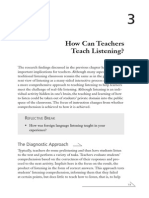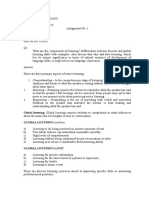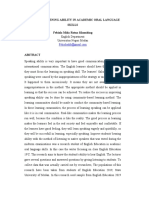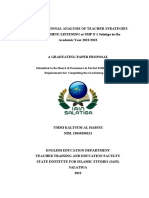Improving The Teaching of Listening: Abstract
Improving The Teaching of Listening: Abstract
Uploaded by
Siti Nur HamizahCopyright:
Available Formats
Improving The Teaching of Listening: Abstract
Improving The Teaching of Listening: Abstract
Uploaded by
Siti Nur HamizahOriginal Title
Copyright
Available Formats
Share this document
Did you find this document useful?
Is this content inappropriate?
Copyright:
Available Formats
Improving The Teaching of Listening: Abstract
Improving The Teaching of Listening: Abstract
Uploaded by
Siti Nur HamizahCopyright:
Available Formats
Improving the Teaching of Listening
Abstract: With more and more emphasis being shifted to
communicative competence, both teachers and students have become aware of the importance of listening as a language skill for communication. However, traditional listening classroom seems to have failed to help learners become effective listeners. Many students often complain that they dont benefit much from listening lessons. This partly explains the unsatisfactory listening ability of the listeners. This article examines the problems of the traditional listening class and puts forward suggestions to improve the teaching of listening.
Introduction
English is learned as a foreign language and opportunities for authentic oral practice and listening are few. As a result students are poor in listening and speaking. When they meet native speakers, they find themselves unprepared for the variety of accents(Cortazzi & Jin, 1996). They find it difficult to understand English if it is spoken at natural , normal speed. They lack confidence about their language competence because they have had inadequate practice in listening and speaking. Recently listening has been giving much attention. However, in reality, many teachers often tend to test listening rather than teach it. Those teachers usually begin with the listening of some passage by introducing some difficult vocabularies. Then they play the tape and ask learners to listen carefully. After that, students are asked to finish comprehension exercises. When learners finish the exercises, teachers check the answers and if they find that students get the wrong answer, they will let the students listen again without any explanation. Students easily get tired of such listening exercises. They are not motivated. Whats worse, learners are very likely to get into bad and harmful listening habits. From the above discussion, we can easily tell how serious the problems are confronting listening teachers. Teachers should reorganize their listening class. And a three-stage format for the listening lesson
1
can be designed: pre-listening, while-listening and post-listening.
Pre-listening
Pre-listening is the preparation stage for while-listening. The most important thing in this stage is to provide sufficient context to match what would be available in real life and to create motivation. This can be realized by helping learners become conscious of the purpose of the upcoming listening input. As some researchers claim, listening is always with a purpose or some reason, because listeners are limited processors (Anderson & Lynch, 1988; Brown, 1990). Therefore, teachers should help listeners narrow down their attention for the upcoming input and focus their attention on the relevant part so as to lessen the load of listening. Pre-listening activities can be brainstorming, discussing the topic of the listening text, predicting and pre-teaching vocabulary. This stage should be restricted to a few minutes. Excessive discussion of the topic may mean that too much of the content of the listening passage has been anticipated. Concerning pre-teaching some vocabulary, it may only be necessary for the teacher to present two or three key words without which understanding of the text would be impossible, This will match real life situation, where learners cannot expect to have unknown words explained in advance. [ Another important function of pre-listening is to give full play to learners initiatives by activating their background knowledge. Learners are not passive in their listening, rather, they are active mental builders, always ready to draw inferences and make predictions with the help of their internal resources (Anderson & Lynch, 1988). Teachers can divide learners into groups to discuss and predict what they are going to listen to with certain clues. In doing so , learners can be motivated and activated to take part in the classroom activities and consequently can stand more chance of becoming active and successful listeners.
While-listening
While-listening should be a stage at which listening is accompanied by carefully designed activities and experience the pleasure of success. Task-based activities are encouraged. Learners are required to finish some tasks with the information they have extracted from the text. Tasks can be labeling, selecting, form-filling or completing a grid. Students
2
are thus expressing agreement and disagreement, taking notes, making a picture or a diagram according to instructions. Compared with traditional multiple choice questions, task-based exercises can encourage students to use different kinds of listening skills and strategies to achieve understanding in an active way. Task-based activities of this kind reflect much more closely the type of response that might be given to a listening experience in real life. They also provide a more reliable way of checking understanding and the task of filling forms, labelling diagrams on making choices oblige every learner to try to make something of what they are hearing. Afterwards teachers should provide necessary clues such as contextual information of the speakers of the relationship among speakers, etc to help learners to cope with their problems they come across in the process of listening. While-listening is not only a stage to encourage listeners to demonstrate their comprehension and to make their problems plain to the teacher rather than hide them, but also a stage for teachers to teach and help learners build up their listening skills and strategies so as to increase listeners chances of success in listening tasks.
Post-listening
Post-listening is a part that is often neglected by many teachers in China. Actually, there is a lot to do after listening. Activities such as problem solving, summarizing, group discussion and writing as followup are necessary. Instead of spending time examining the grammar of the listening text, we take post-listening as a means of reinforcing recently learned material. If necessary, the teacher can play the while text again and ask the students to compare their understanding of it in pairs or in groups, encourage them to disagree with each other, and increase their motivation for a second listening. After playing the text for the second time, students can revise their views. Instead of telling them who is right and who is wrong, the teacher can ask students to provide evidence to support their views. In this way listening becomes a much more interactive activity. We can also take the chance to let students practice speaking and writing. First they can have discussion and presentation, which at the same time can serve as a pre-writing activity. After sharing ideas, they can write something related to the passage.
3
At the end of the stage, teachers should make sure that necessary feedback to learners performance is offered and received. Learners problems are summarized and tackled by reviewing the difficult parts, and newly taught skills and strategies will be reinforced by encouraging learners to apply them in their out-of-class listening practice.
Conclusion
In teaching listening, there are many things that need to be explored. Teaching listening is more than just playing tapes and testing students comprehension. We must realize the ultimate goal of teaching of listening is to help our students to become competent listeners. And the new approach with a combination of pre-listening, while-listening and post-listening is very helpful to contriute to such a goal. Therefore, introduction of such an approach with the three as integrated parts should be made into our listening class. In doing so, we can help our students develop their listening competence along with other abilities and become effective and successful listener both in and out of the classroom.
References
Cortazzi, M. & Jin, L. 1996. State of the Art: English teaching in China. Language Teaching 29: 61-80 Anderson, A & Lynch, T. 1988. Listening. Cambridge: CUP Brown, G. 1990. Listening to Spoken Language. London: Longman
You might also like
- Teaching English to Speakers of Other LanguagesFrom EverandTeaching English to Speakers of Other LanguagesRating: 3 out of 5 stars3/5 (1)
- Question 1 (A)Document11 pagesQuestion 1 (A)Vinothene GopiNo ratings yet
- Teaching ListeningDocument3 pagesTeaching Listeningdiazjanice.fNo ratings yet
- ESL Listening Comprehension - Practical Guidelines For TeachersDocument3 pagesESL Listening Comprehension - Practical Guidelines For TeacherscristinadrNo ratings yet
- How Can Teachers Teach Listening?Document10 pagesHow Can Teachers Teach Listening?gollakotiNo ratings yet
- A Framework For Planning A Listening Skills LessonDocument10 pagesA Framework For Planning A Listening Skills LessonMa Eugenia Amezquita AcostaNo ratings yet
- Teaching ListeningDocument15 pagesTeaching ListeningJennifer VanceNo ratings yet
- Teaching of The Macro SkillsDocument30 pagesTeaching of The Macro SkillsNiño Naldoza100% (1)
- Listening Comprension by Using Bottom Up Strategies From The Students) - Dina Wasilatur RofiqohDocument7 pagesListening Comprension by Using Bottom Up Strategies From The Students) - Dina Wasilatur RofiqohDina Wasilatur RofiqohNo ratings yet
- Portfolio - Met4Document38 pagesPortfolio - Met4Ali Deza TineoNo ratings yet
- Uas Classroom Management: AnswerDocument5 pagesUas Classroom Management: Answerreza jazmi100% (1)
- The Language Skills 1 TEFL AIOUDocument24 pagesThe Language Skills 1 TEFL AIOUPrince Kazmi100% (1)
- Hbet3403 Asgnmt Listening & Speaking Sept 2019Document13 pagesHbet3403 Asgnmt Listening & Speaking Sept 2019Premalatha a/p S. ThayanNo ratings yet
- An Action Research Plan For Developing and Implementing The Students' Listening Comprehension SkillsDocument4 pagesAn Action Research Plan For Developing and Implementing The Students' Listening Comprehension SkillsDarman ManjiNo ratings yet
- Makalah Tefl IIDocument10 pagesMakalah Tefl IINa Na ChriesnaNo ratings yet
- Enhancing The Listening SkillDocument7 pagesEnhancing The Listening SkillJuan Francisco Hidalgo SandovalNo ratings yet
- PwpDocument10 pagesPwpnhatquynh.141005No ratings yet
- Task 4Document5 pagesTask 4eaglesnestownersNo ratings yet
- Designing Lessons For EFL Listening Comprehension ClassesDocument5 pagesDesigning Lessons For EFL Listening Comprehension ClassesHồng ThắmNo ratings yet
- The Language Skills-I 5659Document25 pagesThe Language Skills-I 5659mubarak201160% (5)
- Thesis Statement Listening SkillsDocument5 pagesThesis Statement Listening Skillssydneynoriegadenton100% (2)
- Listening Strategies and Applications in EFL Classroom: II. MotivationDocument34 pagesListening Strategies and Applications in EFL Classroom: II. MotivationCesar MartinezNo ratings yet
- (PG36-G10-Final Assignment) - 21046937nguyen Thi Anh TuyetDocument9 pages(PG36-G10-Final Assignment) - 21046937nguyen Thi Anh TuyetNGUYỄN THỊ ÁNH TUYẾTNo ratings yet
- MetoDocument12 pagesMetoRana QuliyevaNo ratings yet
- Teaching Listening: Section ContentsDocument27 pagesTeaching Listening: Section ContentsRifqi Syafia100% (1)
- Jeremy Harmer (2007) Chapter 10: Teaching ListeningDocument3 pagesJeremy Harmer (2007) Chapter 10: Teaching ListeningHanif Seumateh100% (1)
- Module 4 - Receptive Macro Skill: Listening EXERCISE Instructions: Discuss Some Ideas by Answering The Following Questions. ExplainDocument2 pagesModule 4 - Receptive Macro Skill: Listening EXERCISE Instructions: Discuss Some Ideas by Answering The Following Questions. ExplainJessel DilaoNo ratings yet
- Teaching Listening and SpeakingDocument29 pagesTeaching Listening and Speakingtforever111991No ratings yet
- Lesson 3 Teaching ListeningDocument8 pagesLesson 3 Teaching ListeningMyra EtosNo ratings yet
- ListeningDocument6 pagesListeningZouhir KasmiNo ratings yet
- Summary TeflDocument4 pagesSummary TeflAlVin AryaGiansNo ratings yet
- ListeningDocument3 pagesListeningA'ron Geron HernandezNo ratings yet
- Aols - Dik19c - Idea Engineering - Febiola M R SDocument15 pagesAols - Dik19c - Idea Engineering - Febiola M R Sesra berutuNo ratings yet
- Teaching Listening and Speaking - 1Document26 pagesTeaching Listening and Speaking - 129camziiNo ratings yet
- Proposal SemproDocument13 pagesProposal SemproNugroho GarinNo ratings yet
- Tugas 2 Esp - Selpia Yunita Ibrahim - 1847041012Document6 pagesTugas 2 Esp - Selpia Yunita Ibrahim - 1847041012Selpia Yunita IbrahimNo ratings yet
- Universidad Católica de La Santísima ConcepciónDocument12 pagesUniversidad Católica de La Santísima Concepciónapi-257908691No ratings yet
- Problem in Listening Faced With The StudentsDocument7 pagesProblem in Listening Faced With The StudentsBadrul Hisham Mohd RidhwanNo ratings yet
- Review of Journal Language Testing and ResearchDocument7 pagesReview of Journal Language Testing and ResearchfloNo ratings yet
- Tape Recorders, Role-Plays, and Turn-Taking in Large EFL Listening and Speaking ClassesDocument6 pagesTape Recorders, Role-Plays, and Turn-Taking in Large EFL Listening and Speaking ClassesLudmilsybillaNo ratings yet
- Topik 2 Tugas Mata Kuliah Esp For Primary TeacherDocument9 pagesTopik 2 Tugas Mata Kuliah Esp For Primary TeacheratriaNo ratings yet
- Listening and SpeakingDocument5 pagesListening and SpeakingMirane HuseynovaNo ratings yet
- A Statement Outlining Educational Beliefs and Teaching StyleDocument4 pagesA Statement Outlining Educational Beliefs and Teaching StylebetulseyhanNo ratings yet
- The Effectiveness of Small Group Discussion To Improve StudentsDocument15 pagesThe Effectiveness of Small Group Discussion To Improve StudentsElsa NurfadilahNo ratings yet
- How To Teach Speaking Activities To ESL StudentsDocument3 pagesHow To Teach Speaking Activities To ESL StudentsThias Arisiana100% (2)
- Môn Phương pháp giảng dạy tiếng Anh Bậc Trung họcDocument10 pagesMôn Phương pháp giảng dạy tiếng Anh Bậc Trung họcTrần HoàngNo ratings yet
- Lac NoteDocument13 pagesLac NoteAdu Charles OseiNo ratings yet
- Planning 1Document8 pagesPlanning 1Слободан Драгана ПоповићNo ratings yet
- Phase 3.1 Teaching Techniques (Language Skills)Document60 pagesPhase 3.1 Teaching Techniques (Language Skills)Madhuri KarnewarNo ratings yet
- Teaching English To Young Learners - SkillsDocument175 pagesTeaching English To Young Learners - SkillsVanaja ThiagarajanNo ratings yet
- The Teaching of ListeningDocument18 pagesThe Teaching of ListeningJanita NikolivaNo ratings yet
- UNIT 7aDocument10 pagesUNIT 7anariamNo ratings yet
- How To Build Listening and Speaking Skills in Young LearnersDocument4 pagesHow To Build Listening and Speaking Skills in Young LearnersAisha AzmanNo ratings yet
- Improve Oral LearningDocument12 pagesImprove Oral LearningRayan RanaNo ratings yet
- Teaching ListeningDocument92 pagesTeaching ListeningApenton MimiNo ratings yet
- Questions 1Document9 pagesQuestions 1iqra khanNo ratings yet
- Thesis Revisi 2 KatrinDocument179 pagesThesis Revisi 2 KatrinVeronika Melisa HaleNo ratings yet
- How To Improve English Instructions For Senior High School Students in IndonesiaDocument3 pagesHow To Improve English Instructions For Senior High School Students in Indonesiaayu suhestiNo ratings yet
- Designing Lessons For EFL Listening Comprehension Classes: Justine RossDocument4 pagesDesigning Lessons For EFL Listening Comprehension Classes: Justine RossabdenbiNo ratings yet



























































